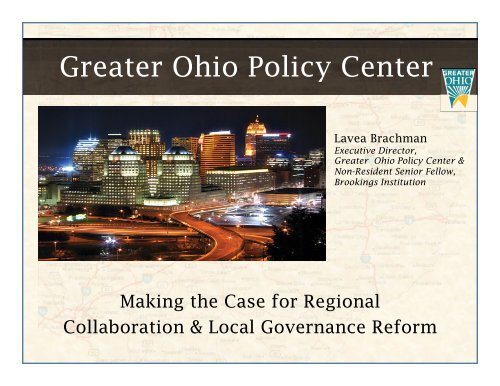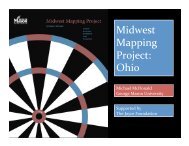Greater Ohio Policy Center - Cleveland State University
Greater Ohio Policy Center - Cleveland State University
Greater Ohio Policy Center - Cleveland State University
- No tags were found...
Create successful ePaper yourself
Turn your PDF publications into a flip-book with our unique Google optimized e-Paper software.
EUCAST DEFINITIVE DOCUMENT E.DEF 2.1 AUGUST 2000Determination of antimicrobial susceptibility test breakpointsEuropean Committee forAntimicrobial SusceptibilityTesting (EUCAST) of the European Societyof Clinical Microbiologyand InfectiousDiseases (ESCMID)INTRODUCTIONThis document is the ¢rst full description of the method ofdetermining clinical breakpoints for antibiotics (for de¢nitionsof terminology, see Clinical Microbiology and Infection,1998; 4: 291^6) that has been used for the past 10 years by theEuropean Study Group on Breakpoints (ESGAB) and now tobe used by EUCAST, its successor. Because of the diversity ofmethodology of susceptibility testing in Europe, particularlyin disk methods, we have determined breakpoints only in relationto MICs. Informal assessment has shown that MICs forcommon non-fastidious bacteria, competently determined bythe methods described by a number of national societies, arevery close and often identical.We are in the process of formalstudyof this comparability.In order to determine breakpoints, the EUCAST BreakpointsSubcommittee requires information from those promotingthe antimicrobial agent. In the pursuit of internationalcollaboration, we have, whenever possible, used the wordingof a version of the NCCLS document M23 which was the subjectof discussion at the time the EUCASTdocument was produced.The wording of this EUCAST document di¡ers fromthat of the published versions of M23 and cannot be used as asubstitute when it is intended to follow NCCLS guidelines.Rather, its purpose is to facilitate the provision of documentationrequired of those seeking a breakpoint determination inEurope.Information required for the determination of antimicrobialsusceptibility test breakpointsIn vitro drug characteristicsInformation is required on the use of diluents and solvents;preparation of stock solutions; stability of the drug in appropriateconcentrations at storage and incubation temperature;and the relationship or comparability of MIC endpointsde¢ned by di¡erent methods, for broth and agar methods andmedia, for relevant representative organisms.Distribution of susceptibility of organismsMICs must be determined on at least 500 isolates (and at least300 anaerobes in addition if relevant, each species in su¤cientnumbers to establish norms, with a note on relative prevalenceamong clinical isolates), which must include examples ofclinically relevant species appropriate to the class of compoundand its proposed clinical use.They must include isolatesshowing important resistance mechanisms. For example,methicillin-resistant Stapylococcus aureus (MRSA) and coagulase-negativestaphylococci should be included for the evaluationof antistaphylococcal agents.The MIC distributions must be shown (not MIC 50 ,MIC 90 , etc.), and compared with those obtained for recentclinical isolates obtained from large geographically diversesurveys.Pharmacokinetics and pharmacodynamicsMethods for measurement of drug concentrations in serumand body £uids must be provided. If bioassay and other methodsare available, their relative performance must be shown.Actual plots must be provided of serum or plasma levels inhumans over time following expected dosages and methods ofadministration. Concentrations in cerebrospinal £uid must bepresented if the drug is to be used for the treatment of meningitis.If available, data from target patient populations shouldbe presented. The number of subjects or patients, characteristics,and intra-and inter-individual variability of measurmentsmust be included.Pharmacokinetic parameters that are also useful for simulation,calculation of pharmacokinetic/pharmacodynamic relationships,and comparisons with other drugs of the same classmust be provided.These parameters must include bioavailability,C max , AUC, volume of distribution, protein binding (andits e¡ect on MIC and pharmacokinetic and pharmacodynamicparameters), metabolism (including data on microbiologicalactivity of metabolites), excretion (with kinetics and e¡ects ofpH and cations in urine, if relevant), clearance, and eliminationhalf-life. The number of subjects should be governed bygood statistical assessments.Data on di¡erences in AUC, expected peak and troughserum concentrations, and pharmacokinetic/pharmacodynamicparameters (e.g. AUC: proposed MIC breakpoint ratio)with anticipated dosage regimens are helpful, if available. Aswell as data on normal human subjects, data on target populationswhich might include children, the elderly and populationswith special dosage requirements (e.g. in renal or hepaticfailure) are desirable.= 2000 Copyright by the European Society of Clinical Microbiology and Infectious Diseases
RestoringProsperityto<strong>Ohio</strong><strong>Greater</strong><strong>Ohio</strong><strong>Policy</strong><strong>Center</strong>
RestoringProsperity’sFindings• <strong>Ohio</strong>CanCompeteinthe“nexteconomy”• Buttocompete,wemustadapt• TheTimetoActisNow
HowDoWeTransiContotheNextEconomy?• Buildonourmetroassets(Innova2on,HumanCapitol,Infrastructure,QualityPlaces)• Transformgovernance• Engagefederalgovernment
GovernanceReformandCollaboraConasanEconomicGrowthToolTocompeteinaglobaleconomy<strong>Ohio</strong>must:1) Reducetheexorbitantgovernmentcostsandeasethebudgetcrisis.2) ReformGovernancetocorrespondtothewaywelivenowinmetrosandregions;and3) WorkinaunifiedandregionallycohesivemannertobemoreeconomicallycompeCCve‐CorrectfragmentaCon.
HowMuchLocalGovernmentDoes<strong>Ohio</strong>Have?
In2002,<strong>Ohio</strong>had13.4moreLocalGovernmentsperCountythantheNaConalAverage120NumberofLocalGovernmentsperCounty10080604020016CountyNEOaverageCuyahogaCounty<strong>Ohio</strong>countyaverageNaConalcountyaverageSource:<strong>Greater</strong><strong>Ohio</strong><strong>Policy</strong><strong>Center</strong>,USCensusofGovernments,2007
TheseProblemsareCompoundedbyaStagnantPopulaKon
WehaveDemographicChallenges<strong>Ohio</strong>’sPopulaConisStagnant29%PopulaCongrowth,2000‐07ProjectedpopulaCongrowth,2000‐307%1%2%U.S.<strong>Ohio</strong>Source:U.S.CensusBureau
ThisLevelofCostBurdenisUnsustainable40%35%30%25%20%15%10%37%Changefrom1997‐200729%5%0%Total<strong>State</strong>andLocalGovernmentExpendituresInflaCon*Dollarsadjustedto2007Source:<strong>Greater</strong><strong>Ohio</strong>,CensusofGovernment,USCensusIntercensal<strong>State</strong>PopulaConEsCmates2%PopulaCon
<strong>Ohio</strong>’sCiCesareShrinkingataRatethatOutpaces<strong>State</strong>wideGrowthTrends
ShrinkagedoesnotstopatcityboundariesCounty Central City Central citypeak yearCounty peakyear% county populationdecline from peakyear to 2000Cuyahoga <strong>Cleveland</strong> 1950 1970 19.0Hamilton Cincinnati 1950 1970 8.5Lucas Toledo 1970 1970 6.1Mahoning Youngstown 1950 1970 15.1Montgomery Dayton 1960 1970 7.8
WhatisThisGovernmentCosKngUs?
TotalExpenditures<strong>State</strong>andLocalGovernmentshaveIncreasedbyNearly50%since1992140,000,000,000120,000,000,000100,000,000,00080,000,000,00060,000,000,000LocalGovernment<strong>State</strong>Government40,000,000,00020,000,000,000‐1992 1997 2002 2007Source:<strong>Greater</strong><strong>Ohio</strong><strong>Policy</strong><strong>Center</strong>,CensusofGovernments
SchoolDistricts,CounCes,andMunicipaliCesAccountfor90%ofallCostsSchoolDistrict;42%County;25%Municipal;24%SpecialDistrict;7%Township;3%Source:<strong>Greater</strong><strong>Ohio</strong><strong>Policy</strong><strong>Center</strong>,CensusofGovernments
ThisLevelofCostBurdenisUnsustainable40%35%30%25%20%15%10%37%Changefrom1997‐200729%5%0%Total<strong>State</strong>andLocalGovernmentExpendituresInflaCon*Dollarsadjustedto2007Source:<strong>Greater</strong><strong>Ohio</strong>,CensusofGovernment,USCensusIntercensal<strong>State</strong>PopulaConEsCmates2%PopulaCon
How<strong>Ohio</strong>Compares• <strong>Ohio</strong>’slocalgovernmentpayrollis10%abovenaConalaverageand17.5%abovepeerstateaverage(IN,MI,PA,KY,WV,IL)• <strong>Ohio</strong>anshave9 th highestlocaltaxburdenintheU.S.andthe34 th highestforstatetaxes• Schools:– <strong>Ohio</strong>ranks47thnaConwideinspendingforinstrucConand9thinadministraConspendingin– <strong>Ohio</strong>’sshareofspendingonschooldistrictadministraConis49%higherthanthenaConalaverage
In2002,<strong>Ohio</strong>had13.4moreLocalGovernmentsperCountythantheNaConalAverageSource:<strong>Greater</strong><strong>Ohio</strong><strong>Policy</strong><strong>Center</strong>,USCensusofGovernments,2007
<strong>Ohio</strong>UndercumngCompeCCveRelaCveto25%Other<strong>State</strong>sMismatchbetweenPercentChangeinPopulaKonandPercentChangeinLocalGovernmentPayroll,1997‐200720%15%PercentChangeinPopulaCon10%5%PerCentChangeinCostofLocalGovernmentPayroll0%*numbersadjustedto2010dollarsSource:<strong>Greater</strong><strong>Ohio</strong><strong>Policy</strong><strong>Center</strong>,CensusofGovernments,CensusBureauAnnualPopula2onEs2mates
HowDoWeAddressTheseChallengestoBeMoreCompeKKve?
PilotsandIniCaCves• RegionalIniCaCves– Northeast<strong>Ohio</strong>‐‐Fund– Southwest<strong>Ohio</strong>–Agenda360• Local– GreeneCounthySchoolsSharedServiceDelivery– Orville‐RiomanSchoolDistrictAdminCompact
<strong>State</strong><strong>Policy</strong>RecommendaCons• Re‐establishtheformer<strong>State</strong>andLocalGovernmentCommission• IncenCvizeinnovaCvegovernanceandservicedelivery• MandatecollecConandstandardizaConofdata• Makelocalgovernmenttaxsharingexplicitlypermissive• AligneconomicdevelopmenteffortstocapitalizeoncompeCCvenessofenCreregions
ReexaminetheFormaConofNewSpecialDistricts1600NumbersandTypesofLocalGovernmentin<strong>Ohio</strong>140012001000800600400CountyMunicipalTownshipsSchoolDistrictsSpecialDistricts20001952 1962 1972 1982 1992 1997 2002
ConsolidaConsandMergersareNotNewfor<strong>Ohio</strong>1600NumbersandTypesofLocalGovernmentin<strong>Ohio</strong>140012001000800600400CountyMunicipalTownshipsSchoolDistrictsSpecialDistricts20001952 1962 1972 1982 1992 1997 2002
<strong>Greater</strong> <strong>Ohio</strong> <strong>Policy</strong> <strong>Center</strong>




